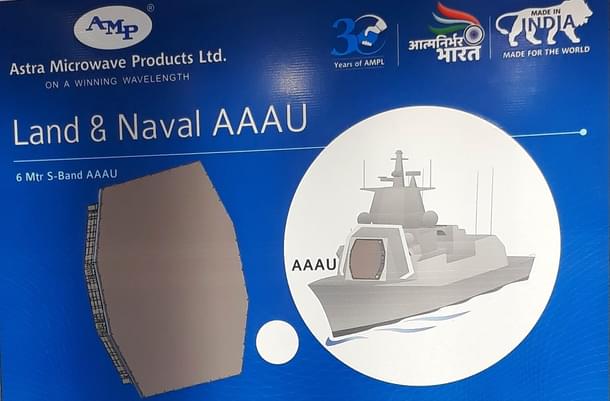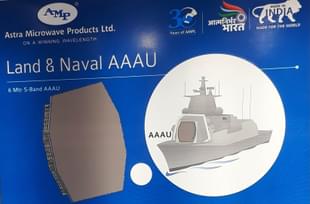Defence
Explained: The Indian Navy's New Game-Changing Radar
Venu Gopal Narayanan
Aug 08, 2023, 04:43 PM | Updated 04:46 PM IST
Save & read from anywhere!
Bookmark stories for easy access on any device or the Swarajya app.


On 31 July, a Hyderabad-based company named Astra Microwave Products Pvt. Ltd. issued its annual report. Buried in dry text, under the heading “Major projects due for delivery during the year 2023-24”, was an innocuous line item: “6 Mtrs S-Band AAAU for strategic Naval application of DRDO”.
Hardly anyone has read the report, and most of those who did would have glossed over the arcane acronym, but the news was enough for our ever-alert Defence Twitter to explode in ecstatic frenzy.
As is the wont of this curious breed, social media was soon filled with an array of befuddling acronyms: LR-MFR, BMD, LRSAM, IFEP, SBR, and more.
To fully understand the reasons behind such heady jubilation, we must travel back in time to 16 August 2014, and the commissioning of the INS Kolkata, our first Kolkata-class stealth guided-missile destroyer.
That is when Prime Minister Narendra Modi made, what is probably, his first strategy speech. Standing on the decks of a truly fearsome warship, which bristles with racks of the near-unstoppable Brahmos supersonic cruise missile, he said that military prowess was the biggest deterrent to war.
The symbolism was unmissable even to the blind. Yet, as lethal as the Brahmos is, the warship’s greatest strength is actually the cutting-edge Israeli radar it carries – the EL/M-2248 MF-STAR, since such vessels are only as good as the sensors they have.
The ability to sail upon distant blue waters, to land a punch with a Brahmos, is possible only if a warship is protected by a radar which can detect inbound threats in advance.
And this Israeli radar is so good that the Indian Navy standardized it for succeeding classes of warships as well: the follow-on Vishakhapatnam-class destroyers, and the Nilgiri-class frigates presently under construction and commissioning.
The Israeli radar has four antennae covering all four quadrants. Each antenna is three meters by three meters wide, and can detect multiple targets approaching in multiple profiles from multiple directions – be they fighter aircraft at high altitudes, or low-flying missiles which skim the sea.
This is important, and necessary, since the role of destroyers and frigates is not just to fire offensive weapons like the Brahmos, but to defend a fleet – especially aircraft carriers. Essentially, force projection is a function of protection offered by such radars.
Above this is a broader function of theatre-level ballistic missile defence. This concept was pioneered some decades ago by the American Navy and has become a stock-in-trade feature of large navies today, with the ability of detect, track, and destroy such threats improving in step with advances in radar technology.
The Americans are developing a new radar for their Arleigh Burke-class destroyers. Called the AN/SPY-6, and sized at 4.3 meters, it is larger than the Israeli radar. While requisite details are not available, this new radar is expected to offer significantly enhanced capabilities, to both detect threats earlier, and to counter saturation attacks (multiple missiles launched simultaneously at a target).
Similarly, the antenna of the Chinese Type 346B radar (called the ‘Star of the Sea’) being installed on their latest Type 055 destroyers is 4 meters in diameter.
Putting it all together at sea is a lot more complicated than setting up such systems on land, because diverse components, all large and heavy, have to fit onto a single ship. But once done, these radars, integrated with offensive and defensive missile systems, allow navies to dominate vast swathes of ocean in an elegant, efficient manner.
That is why the Israeli radar on board the Kolkata is called an MF-STAR: a Multi-Function Surveillance, Track And Guidance Radar.
A hypothetical war scenario puts these functions in perspective: The Indian Navy’s Western Naval Command is tasked to conduct an amphibious assault on the Makaran Coast of Baluchistan, using the Indian Army’s premier amphibious force – 91 Brigade (The Amphibians) based at Trivandrum in Kerala.
To succeed, the INS Kolkata and her sisters would have to simultaneously ward off fighter jets launched from Pasni Air Base, plus a clutch of missiles including the ballistic Shaheens and Ghauris, and cruise missiles like the Babur and the Exocet, while locating key targets to guide their own Brahmos missiles towards.
Astra Microwave’s new radar is a major step forward in this challenging domain.
With a diameter of 6 meters, it is a whopper!
Even the Americans, whose strategic planners have been screaming for a 6-meter antenna for years, have been restricted to a 4.3-meter radar because that is all the deckhouse of an Arleigh Burke-class destroyer can accommodate.
In technical terms, this radar is called an AAAU – an Active Antenna Array Unit.
Very little information is available about it in the public domain (and rightly so), but we do know that it has been installed on the Indian Navy’s secretive testbed, the INS Anvesh (which was commissioned into the Navy in a low-key ceremony early last year).
The technology was originally developed by India’s Defence Research Development Organization, the venerable DRDO, as the core of its AAAU programme for the Indian Air Force. Its functions span the spectrum of electronic warfare, and, very importantly, electronic countermeasures as well.
An antenna diameter of 6 meters means a surface area of 36 meters. Pertinently, that makes this radar four times larger than the Israeli one currently installed on our frigates and destroyers.
The implications are stupendous, since the larger the surface area of an antenna, the more the number of transceivers can be installed on it; and the more such nodes an antenna has, the more powerful the radar becomes.
So, what are the implications of this landmark moment?
First, it is now obvious that the India is developing an extremely advanced radar for a new class of warships.
We don’t yet know what those surface vessels are, but readers may bear in mind that the two primary ongoing naval construction programmes, for the Vishakhapatnam-class destroyers and the Nilgiri-class frigates, will be completed in the period of 2024-2026.
There are unconfirmed rumours of a new class, dubbed the ‘Next Generation Vessel’, or ‘Project 18’.
These warships, to be built entirely in India, are expected to be far more potent than anything the Indian Navy currently possesses (or other large navies, for that matter), but frankly, without official confirmation, the bottom line is that we simply don’t know.
All we know for sure is that the docks at Mazagon, Kochi and Kolkata, will not be left to quietly gather moss once the current programmes are completed.
Second, a 6-meter antenna is one more bit of evidence to show that India’s defence industry is not just catching up with the rest of the world, but slowly, very slow, moving ahead in some sectors as well.
Third, the Astra AAAU is expected to complement the Israeli MF-STAR radar installed on our destroyers and frigates.
It will be a good mix, which provides greater ability to dominate larger sweeps of ocean more efficiently, and more comprehensively, with multiple, integrated layers of both offence and defence.
Fourth, this new radar will exponentially bolster our ballistic missile defence systems. We must also bear in mind that the next class of warships will be much larger, for the simple reason that their deckhouses will have to be expanded to accommodate a 6-meter-wide antenna.
This also means that such vessels would be able to carry larger, more advanced missiles in greater numbers, providing that much more dominance.
Fifth, the fact that this new radar was built by Astra Microwave shows that active efforts at indigenization are paying off.
Public-private partnership, a cornerstone of the Indian government’s Atmanirbharta policy is working, and well on its way to achieving critical mass.
In conclusion, and at long last, India is no longer building to catch up, but for the future. And this new radar, when commissioned, will aid our forces in living up to the motto of the INS Kolkata – ‘Yudhay Sarvasannadh’, or, ‘Always Prepared for Battle’.
With inputs from @Firezstarter1
Venu Gopal Narayanan is an independent upstream petroleum consultant who focuses on energy, geopolitics, current affairs and electoral arithmetic. He tweets at @ideorogue.





